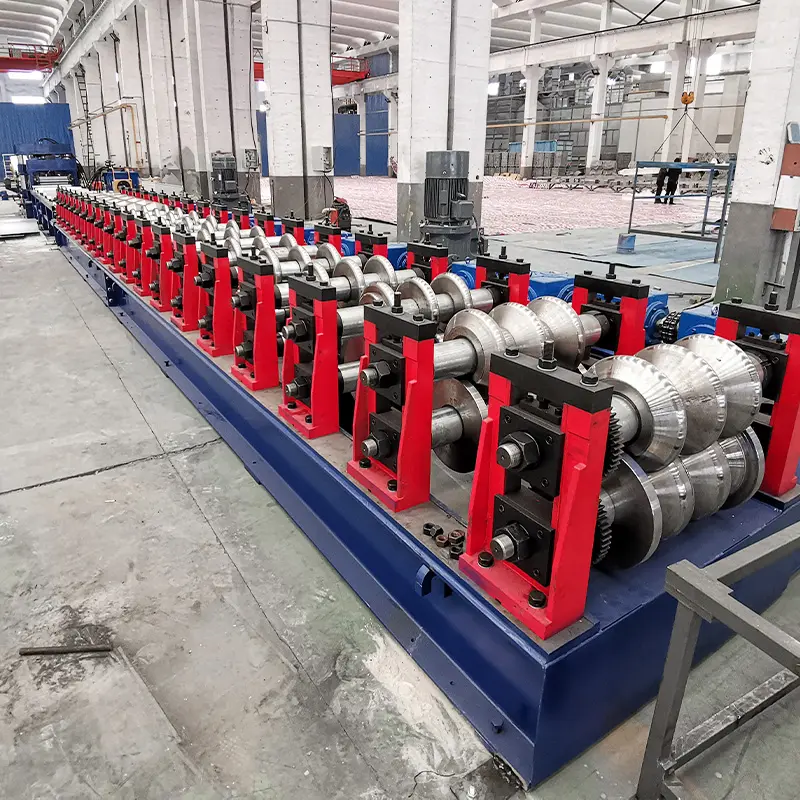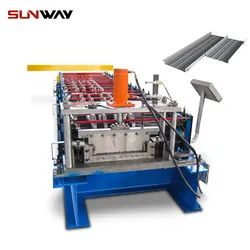Overview of Engel Roll Forming Machines
Engel roll forming machines are high quality roll forming systems used to produce metal roofing, panels, decking, solar module frames, and various structural profiles. Key features:
- Offered by Engel Machinery Inc., a major roll forming equipment supplier.
- Continuous production of profiles from coiled sheet metal.
- Capable of complex profiles with ribs, curves, embossing and other features.
- Quick changeover of roll tooling for flexible production.
- Range of automation options available for material handling, cutoff, and part stacking.
- Touchscreen HMI controls with recipe storage for easy changeovers.
- Used by manufacturers to produce cladding, panels, roofing for building industry.
- Servo roll adjustment and passive roll technology for quality parts.
Typical Products Made on Engel Roll Formers
- Metal roofing – standing seam, horizontal, tile, shake
- Wall panels, siding, liners
- Structural studs, girts, joists, tracks
- Floor and roof decking
- Solar module frames
- Special architectural profiles
Engel machines produce a wide range of standard and custom building components.
Key Specifications
| Parameter | Capabilities |
|---|---|
| Forming width | 18 – 80 inch range |
| Material thickness | 26 ga – 3/16 inch |
| Forming speed | Up to 400 ft/min |
| Pass schedule | Up to 20 forming stands |
| Controls | Touchscreen HMI, servo roll adjust |
| Tooling | Quick change cartridges, driven stands |
| Safety | Guarding packages, light curtains |
Engel offers many standard models plus custom engineered solutions.

How to Select an Engel Roll Former
Key factors when selecting an Engel roll forming system:
- Production requirements – Desired hourly output rate, coil widths/gauges, complexity of profiles to be produced.
- Automation needs – Determine if manual or powered material handling, part cutoff, and stackers are required.
- Tooling – Evaluate availability of standard tooling packages for desired profiles from Engel.
- Controls – Determine necessary functionality like recipe storage, data logging, etc.
- Technical support – Engel provides installation support, training, and service. Ensure regional availability.
- Customization – Engel can provide customized features, safety add-ons, and instrumentation.
- Expandability – Select a system that can have capacity increased in the future with capability to add additional passes.
Work with Engel application engineers early when specifying equipment to get a system tailored to your production requirements.
Roll Tooling Design Principles
Proper roll tooling design is key to producing quality roll formed parts efficiently on an Engel machine. Design guidelines:
- Optimize part profiles for material flow and stiffening ribs, seams, and embossments to add rigidity.
- Engineer roll contours to guide material through forming without thinning, tearing or cracking.
- Design forming passes and roll penetration carefully to control stresses induced in material.
- Match roll diameters top-to-bottom to ensure even bending and precise tolerances.
- Lubricate rolls to reduce friction – use materials like urethane that support metal flow for hard alloys.
- Reduce sharp bend angles which concentrate stress by using larger radii bends.
- Annotate tooling drawings thoroughly with pass sequences and references to aid setup and changeovers.
Work jointly with Engel tooling engineers to arrive at optimal roll designs and sequences for robust production.
Preparing for Engel Roll Former Installation
To prepare for arrival and installation of a new Engel roll forming system:
- Arrange for electrical supply required – confirm voltage, capacity. Install disconnects.
- Provide adequate space with clearances for safe operation around machine. Allow for part conveyors.
- Obtain any necessary permits – building, electrical, local codes.
- Prepare rigid foundations according to Engel specifications to handle loads.
- Have lifting equipment available – cranes, forklifts, chains etc. to offload components from trucks.
- Schedule qualified technicians for installation, alignment, wiring, and debugging.
- Order initial tooling packages and material coil stock to have on hand.
Thorough planning minimizes delays and issues when the equipment arrives onsite.
Installation Best Practices
Recommended practices when installing Engel roll formers:
- Carefully offload components from trucks using appropriate lifting devices. Avoid damage.
- Follow Engel documentation for proper assembly sequence and alignments.
- Have electricians install power connections and control wiring per electrical prints.
- Anchor machine securely to flooring – forming induces dynamic loads.
- Install all safety guarding before powering up machine. Eliminate pinch points.
- Validate proper jog direction on drives prior to running. Reverse as needed.
- Gradually power up and cycle machine to confirm correct operation.
- Make roll adjustments from infeed to exit end to debug tooling pass by pass.
- Only release for production after successful commissioning trials prove out line.
Careful installation by qualified personnel helps avoid issues and ensures a smooth startup.
Roll Former Operation and Quality Control
To safely operate an Engel roll former at optimal quality:
- Monitor line speed, web alignment, roll loads, and other variables continuously. Make adjustments as needed.
- Frequently check formed part dimensions using go/no-go gauges. Ensure within tolerance.
- Ensure input coil parameters match Engel recommendations – thickness, width, tensioning, lubrication etc.
- Promptly replace any worn roll segments before scratches form on parts.
- Schedule downtime for preventative maintenance during planned production stops.
- Implement programmed safety stops and light curtains that halt operation when a fault occurs.
- Control lubrication levels and top up reservoirs as needed to support continuous high speed operation.
- Ensure operators are properly trained on all procedures and safety precautions.
Consistent quality output requires continuous monitoring, training, and disciplined operation within proven parameters.
Common Roll Forming Defects and Corrections
| Defect | Possible Causes | Corrections |
|---|---|---|
| Burrs | Roll damage, web misalignment | Dress or replace rolls, realign guides |
| Wavy sections | Improper roll adjustment | Re-pen roll passes incrementally |
| Twisting | Non-parallel top/bottom rolls | Realign bottom roll parallel to others |
| Thinning | Excessive roll penetration | Loosen roll penetrations, shim gaps |
| Loose curl | Inconsistent roll adjustment | Gradual re-adjustment of problem passes |
| Scratches | Grit on rolls, web contamination | Clean rolls, improve input material surface |
Observe part features closely and make systematic adjustments until defects are eliminated.
Roll Former Safety Considerations
Important safety practices when operating Engel roll formers:
- Comprehensive operator training on hazards and proper procedures.
- Adequate guarding around all pinch points, gears, coils. Avoid exposed hazards.
- Lockout/tagout for maintenance activities and clearing jams. De-energize machine.
- Enforce PPE requirements including snug clothes, gloves, glasses, and hearing protection.
- Clearly mark out safety zones around machine. Follow any access rules.
- Implement automatic safety stops for unsafe conditions like line jams.
- Dust collection if needed to improve air quality in forming area.
- Regular safety inspections to proactively identify risks – document corrective actions.
Prioritizing safety improves work conditions and prevents injuries. Follow all regulatory requirements.

FAQs About Engel Roll Forming Machines
Q: What types of metals can be roll formed on an Engel machine?
A: Most ductile metals including steel, stainless steel, aluminum, copper alloys. Softer, thinner material forms easiest.
Q: How long does it take to set up tooling for a new profile?
A: On quick change machines, typical setup time is 1-3 hours including pass debugging. More difficult profiles may take longer.
Q: What thickness range can be roll formed?
A: Standard Engel models accommodate thicknesses from 0.5 mm to 4.75 mm (26 ga to 3/16”). Special models available outside this range.
Q: What factors determine maximum production speed?
A: Material thickness/hardness, part complexity, available horsepower, and desired quality determine maximum stable speed.
Q: How are roll formed parts cut to length?
A: Servo-operated cutoff presses or saws automatically cut parts to length at preprogrammed intervals. Lengths up to 65 ft are possible.
Q: What tolerances are possible with roll forming?
A: When maintained properly, roll formed parts typically hold dimensional tolerances around ±0.5 mm (±0.02 in). Tighter tolerances become difficult.
Q: How often must roll tooling be replaced?
A: On average every 1-3 months for high production 24 hour operations. Quick change tooling reduces downtime for replacement.
Q: What safety precautions are most important?
A: Training, guarding, lockout, marked safety zones, dust collection, interlocks, modification control, PPE, and periodic auditing.
Q: Can custom roll formed profiles be made?
A: Yes, Engel engineers can design custom tooling packages to produce specialized non-standard parts based on application requirements.
